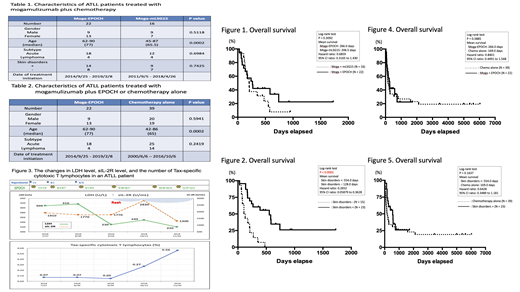Introduction: Adult T-cell leukemia/lymphoma (ATLL) is a rare and quite refractory peripheral T-cell lymphoma. The human T-lymphotropic virus type 1 (HTLV-1) retrovirus causes ATLL. Tax protein produced by HTLV-1 has oncogenic activities, and its peptides can be recognized as tumor antigens by the host immune system. Therefore, some immunological approaches to treat ATLL are effective. Mogamulizumab (Moga), an anti-CCR4 monoclonal antibody, and lenalidomide, an immunomodulator, have been recently approved for newly diagnosed and/or relapsed/refractory aggressive ATLL in Japan. However, to date, satisfactory treatment results have not been obtained with these drugs. Before approval of Moga and lenalidomide, VCAP-AMP-VECP (mLSG15) therapy was one of the standard combination chemotherapies for aggressive ATLL. A randomized phase II study comparing Moga plus mLSG15 and mLSG15 alone showed a higher %CR in Moga plus mLSG15 arm but no significant difference in overall survival (OS) between the two arms. In this study, we compared the outcomes of Moga plus EPOCH with those of Moga plus mLSG15.
Methods: Aggressive ATLL patients, who were ineligible for hematopoietic stem cell transplantation (HSCT) and were newly diagnosed after June 2000 in our hospital, were retrospectively analyzed.
Results: Table 1 summarizes the patient characteristics. Twenty-two patients were treated with Moga plus EPOCH, and 16 were treated with Moga plus mLSG15. There was no significant difference in gender and disease subtype between the groups. Moga-induced skin disorders, such as rash and erythema, were observed in 14 (64%) patients treated with Moga plus EPOCH group and 9 (56%) patients treated within Moga plus mLSG15; the difference was not significant. Figure 1 shows OS of both groups. There was no significant difference (P=0.3092), but a 30% risk reduction was observed in the Moga plus EPOCH group (hazard ratio [HR]: 0.6859, 95% confidence interval [CI]: 0.3165−1.430), though patients treated with Moga plus EPOCH were significantly older than those treated with Moga plus mLSG15 (Table 1). Figure 2 shows OS of patients with and without Moga-induced skin disorders in both groups. The OS of patients with skin disorders was significantly greater than that of those without skin disorders (P<0.0001, HR: 0.2653, 95% CI: 0.05879−0.3628), as previously reported. Elevation of the Tax-specific cytotoxic T-lymphocytes (CTL) percentage was observed after occurrences of skin disorders in some patients. Representative data are shown in Figure 3. These data suggest that the combination chemotherapy regimen might be irrelevant for patients with Moga-induced skin disorders. Next, the OS of the Moga plus EPOCH group was compared with that of those treated with chemotherapy alone, such as mLSG15 and the CHOP-like regimen, as the historical control (Table 2). There was no statistical difference between the groups, but a 16% risk reduction was observed in the Moga plus EPOCH group (P=0.5885, HR: 0.8401, 95% CI: 0.4491−1.568) (Figure 4), though those treated with Moga plus EPOCH were significantly older than those treated with chemotherapy alone (Table 2). A 36% risk reduction in OS was observed in patients with Moga-induced skin disorders compared to those treated with chemotherapy alone (Figure 5).
Conclusion: Improved OS was observed more frequently in the Moga plus EPOCH group than in the Moga plus mLSG15 group. However, to date, Moga plus chemotherapy has not shown a significant impact on OS for newly diagnosed aggressive ATLL patients in non-HSCT settings, except for patients with Moga-induced skin disorders. Elevation of the Tax-specific CTL percentage was observed in some patients with Moga-induced skin disorders. We previously reported in the 2014 ASH annual meeting that several aggressive ATLL patients, who obtained long-time survival using chemotherapy alone, had maintained Tax-specific CTLs for long periods. Therefore, it might be necessary to induce, up-regulate, and maintain ATLL-specific CTLs to obtain long-time survival. Moga is useful, but insufficient, for inducing such CTLs by suppressing regulatory T-cells. No effective method is available to activate an ATLL-specific cellular immune response. Further studies are urgently needed to establish effective methods for attaining ATLL-specific CTLs.
No relevant conflicts of interest to declare.
Author notes
Asterisk with author names denotes non-ASH members.


This feature is available to Subscribers Only
Sign In or Create an Account Close Modal